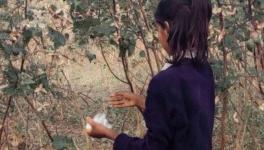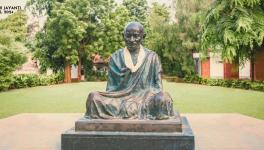Cheetah in Lion’s Clothing? Displaced Villagers in MP Feel Cheated
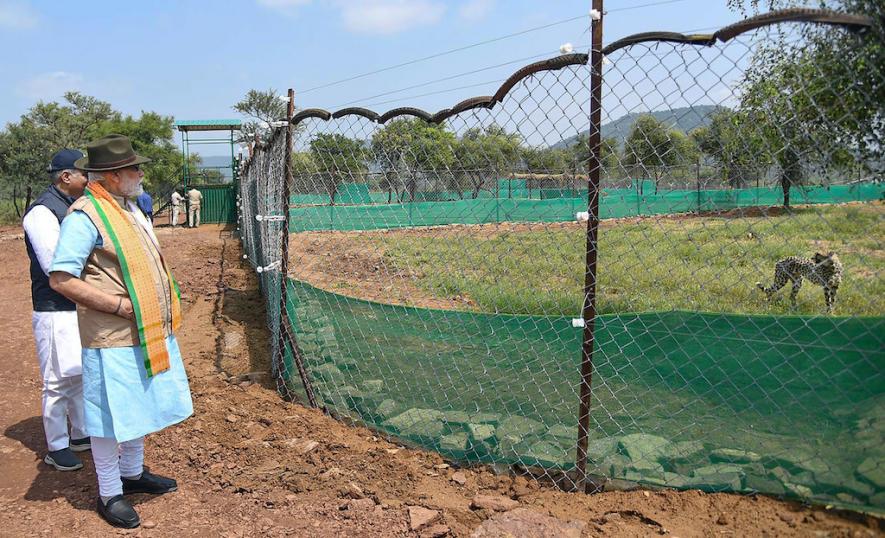
Bhopal: The release of the eight cheetahs in Madhya Pradesh’s Kuno National Park has triggered apprehension and anger among villagers and tribals living around the wildlife sanctuary.
In a first-of-its-kind intercontinental translocation project, Prime Minister Narendra Modi released five female and three male cheetahs transported from Namibia on his 72nd birthday on Saturday.
The inhabitants hope that the arrival of the cheetah—which went extinct in the country in 1952 due to habitat destruction and overhunting—after 70 years might boost wildlife tourism in the region but are also miffed that they were displaced as part of the initial plan of introducing the Asiatic lions from Gir National Park, Gujarat, which was unsuccessful.
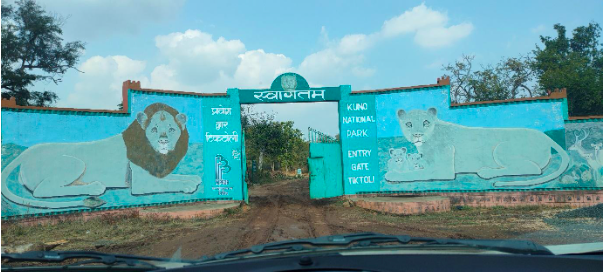
The Palpur royal family vacated its fort, gave up 260 acres and helped the state government by convincing the inhabitants of 24 villages to relocate after the area was designated a wildlife sanctuary in 1981.
“Making Kuno Forest a national park was my grandfather Jagmohan Singh’s vision. In 1981, he laid the cornerstone and gave up acres along with the fort for the rehabilitation of lions,” Shreegopal Deo Singh, a descendent of the Palpur royal family, which ruled Kuno-Palpur, told Newsclick.
Singh claimed that he wasn’t invited to Modi’s birthday celebration on September 17, the formal opening of the national park, because of his opposition to the introduction of cheetahs.
The project, which aims to rehabilitate cheetahs and develop Kuno as a major habitat for the big cats, hasn’t gone down well with the royals and many displaced villagers. They allege that the forest department lured them in the name of introducing the Asiatic lion two decades ago but brought in cheetahs instead.
The royal family vacated the fort—popularly known as Palpur Garhi and located in the core area of the park—gave up 260 acres and helped the state government by convincing the inhabitants of 24 villages to relocate after the area was designated a wildlife sanctuary in 1981.
Singh said that his grandfather, a three-time MLA from the Vijaypur Assembly seat from 1967 to 1980, was an avid wildlife conservationist and wanted to preserve Kuno. He was first elected as an Independent, then on a Bharatiya Jana Sangh ticket and then finally switched to the Congress and was elected for the last time in 1980.
Now, the royal family has moved to the court to get its properties back since they were vacated for lions, not cheetahs.
After an epidemic called ‘canine distemper virus’ killed 30% of lions (approximately 2,500) in Tanzania’s Serengeti National Park in 1994, India decided to translocate the Asiatic lions from Gir as a precaution. Dehradun-based Wildlife Institute of India identified Kuno as the natural habitat of the lions and recommended introducing them there.
Successive Union governments planned to introduce the lions in three phases in a span of 20 years: the first phase (1995-2000) comprised preparation, the second (2001-2005) resettlement of the lions and the third (2006-2015) to increase their population.
However, the then-Modi-led Gujarat government refused to send the lions during the second phase. According to sources in the Madhya Pradesh government, Gujarat does not want the ‘pride of Gir’ to be seen anywhere else.
In the meantime, a separate study mentioned the resettlement of African cheetahs in Kuno.
The UPA government’s 2010 proposal to import African cheetahs was challenged before the Supreme Court (SC) in May 2012 and was subsequently stayed.
A year later when wildlife activists approached the SC in April 2013 following Gujarat’s refusal to send the lions and the forest ministry’s proposal to import cheetahs, the apex court in a strongly worded observation said that a “detailed scientific study has to be done before introducing a foreign species to India, which has not been done in this instance” and quashed the decision to import the predators.
“At this stage, in our view, the decision taken by the ministry to first introduce African cheetahs in Kuno and then the Asiatic lion is arbitrary and illegal,” the top court observed making it clear that the priority is to protect the endangered lions by giving them a second residence. However, despite the SC’s ruling, Gujarat did not budge.
The SC also directed the ministry and Gujarat to start relocating the Gir lions in Kuno. Subsequently, the Gujarat government started a legal fight against the decision. In 2017, the National Tiger Conservation Authority moved the top court for a review of its 2013 decision.
After seven years in 2020, the apex court overturned its earlier decision and consented to introduce the cheetah in Kuno.
Between 1996 and 2002, 1,545 families in 24 villages were relocated from their forest and ancestral home Kuno to other places. According to a research, about 5,000 people lived in these villages out of which nearly 90% belonged to the Sahariya tribe, a Particularly Vulnerable Tribe Group which has historically been subsisting on forest produce.
A forest officer who was assigned to the Kuno relocation project requesting anonymity told Newsclick that the Sahariya community and the Gujjars had easily agreed to relocate after being informed of the project to introduce the lions.
“We told them that every family will get two hectares for farming, 502 square metres for constructing a house and financial assistance of Rs 1 lakh in exchange for relocating. The aid package included the development of agricultural land, construction of houses, transportation of household goods, development of community facilities and cash payment, etc,” the official said.
Madanu Adivasi, who was displaced from Kuno, said that Shariyas were mostly dependent on forest, not farming. “While returning home after fishing, we brough gum, honey and other forest products. But even after 25 years of displacement, the villagers are struggling for basic facilities. The promises made to us during the relocation remain unfulfilled. Besides, forest personnel treat us like criminals when we enter the forest,” he said.
Kalla Adivasi, who was displaced as well, got emotional while describing one of the community’s traditions. “A Sahariya family gifted 5-10 salai (Sal) trees as a present to their future son-in-law during marriage. It was his responsibility to protect the tress and he had the right to harvest the produce for survival. The forest and tribals were interdependent. After our displacement, those trees and the tradition has also almost ended,” he told Newsclick.
“We left our home, land, traditions and way of life in the name of the lion. But at the end, we got cheetahs,” Kalla said adding that “at least, the government is brining something after so many years that may change our lives and source of livelihood”.
Another tribal sarcastically commented, “The forest initially belonged to the Adivasis, but now belongs to the government.”
The Gujjars, who were a dominant community among the displaced villagers, depended on cows and buffalos for livelihood and on the forest for their fodder. Most tribals or Gujjars owned, at least, 50-100 bovines. After the displacement, they neither have enough money to keep as many animals nor fodder to feed them. Forest personnel don’t let them enter the forest.
When the Gujjars protested, the forest department allowed them to graze cattle near Bagcha village in the core zone (then in the buffer zone). Now, even that portion of forest is off limits with any cattle found grazing there taken captive and their owners slapped with a fine of up to Rs 11,000.
Many Gujjar families sold off the almost-barren land given to them by government as part of compensation at a very less rate and rebuilt their homes in Tiktoli village, adjacent to Kuno forest.
Naresh Gujjar, of Tiktoli, said, “My village is adjacent to Kuno forest. The place where we were allowed to graze cattle is 5 km away from there. If we graze our cattle there, the forest department fines us thousands of rupees and confiscates our animals and bikes. A few days ago when I went to graze my animals there, my bike was confiscated and released only after I paid a fine of Rs 11,000. I wasn’t provided a receipt for the payment.”
Nawab Gujjar, who too relocated to Tiktoli, said that several villagers initially opposed relocation but consented when informed of the lion project. “I also agreed to move out. But even after 20 years, the lions never arrived and now Beelai (cheetahs) have been imported from Namibia.”
Shreegopal Singh recalled how every Sahariya family owned 50-100 cows. “Now, due to limited grazing space, these people can hardly keep even five cows. Their traditions that connected them to nature have also almost ended. They used to collect honey, gum and many types of herbs.”
According to Singh, family members have to pay Rs 1,300 like tourists to visit their ancestral home. Besides, they were “denied permission” to visit their ancestral fort and a temple.
The enraged royal family has filed a lawsuit against the forest department in the sessions court seeking permission to visit the fort and the until the ongoing lawsuit is settled.
“During the land acquisition process, almost 1,500 peasants inside the sanctuary received compensation for their land, cattle, trees and other possessions but the royal family received nothing,” Singh alleged.
Land prices around Kuno had shot up after the news of the proposed introduction of the lions. Now, the prices have now sky-rocketed after the arrival of the cheetahs.
After Kuno was declared a national park in 2018 and its boundaries were restructured, only residents of Bagcha village remained to be relocated. The last village of Kuno, dominated by the Sahariyas, will be relocated by year-end. The 190 families identified by the forest department during a survey hope that they won’t be treated unfairly like the other displaced.
“We don’t have a say in whether cheetahs or lions are introduced as it’s a government scheme. But I hope all the promises made will be fulfilled during relocation,” said Dinesh Adivasi, a resident of Bagcha.
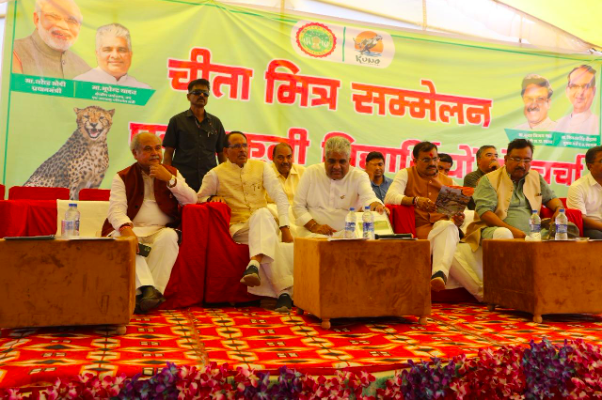
The Madhya Pradesh government’s Cheetah Mitras visit villages, explain the differences between lions, cheetahs and tigers and convince villagers by explaining the benefits of the project.
Following the discontent against the introduction of the Cheetahs, the forest department has roped in more than 500 Cheetah Mitras from nearby 50 villages who hold meetings to list out the ‘financial and environmental benefits’ of the project. They will also keep an eye on the movement of the cheetahs and protect them.
Cheetah Mitras visit villages, explain the differences between lions, cheetahs and tigers and convince villagers by explaining the benefits of the project. “Cheetah don’t hunt humans like lions. They will not attack your villages or ruin your crops. If the government would have brought lions, it would not have been exclusive as Gir already has them. Now, only Kuno has cheetahs in the country and will bring prosperity and tourism to the region,” they say.
Prakash Verma, divisional forest officer, Kuno, told Newsclick that the department is “trying to create awareness about wildlife conservation among villagers” through Cheetah Mitras. “We are explaining the financial and environmental aspects, how the project will bring prosperity to the region, their duty to protect the big cats and help the forest department in developing areas suitable for cheetahs.”
“We are also explaining the do’s and don’ts of the national park,” Verma said adding that more than 1,000 Cheetah Mitras will be hired to work as a bridge between villagers and the forest department and monitor the cheetahs throughout the day”.
Get the latest reports & analysis with people's perspective on Protests, movements & deep analytical videos, discussions of the current affairs in your Telegram app. Subscribe to NewsClick's Telegram channel & get Real-Time updates on stories, as they get published on our website.











